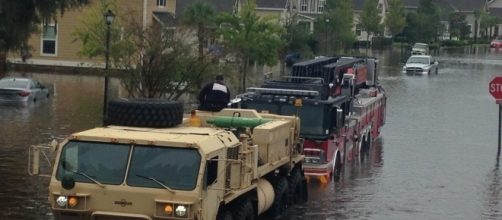Tropical Storm Harvey has managed to put the entire city of Houston, Texas underwater. Now it appears that he has returned to inundate yet another Texas city. After resting but a New York minute, Harvey returned on Wednesday morning to slam into the Louisiana coast where it borders with Texas. Port Arthur is now underwater and their 911 operators are overwhelmed. The mayor was quoted by CNN as saying, “If you called we are coming. Please get to higher ground if you can, but please try to stay out of attics.”
Port Arthur, is just 90 miles east of the Houston area and they are already so flooded the water has filled an evacuation center to near waist deep.
Victims of the flood seeking shelter there are now standing in knee deep murky brown flood water. Some are sitting on tables and dangling their feet in the water. The damage in Houston is still not fully realized. Thousands have been rescued, but nowhere near enough to account for the 60 to 70,000 emergency calls that came in. The damage in Rockport is heartbreaking. But all told, there have been 33 Texas counties granted Federal disaster declarations. What should follow is a little flood education. Since these Texans will be dealing with this for probably years to come.
Dangers of flood waters. What lurks beneath?
If one simply considers the water, it might seem relatively harmless, like taking a very long swim in dark murky waters with a heavy undertow.
Sadly, many in Houston have already realized, that was a grave error. Understanding the health hazards that can, and do, accompany such gargantuan floods is crucial.
Bodies are starting to turn up and one can expect, it is going to be bad. About 75% of the people that die in floods do so from drowning. In Australia, between 1997 and 2008, 1 in 4 flood related deaths were a result of swimming, surfing, or some other kind of careless recreational behavior. It seems people do not understand the dangers of flood waters.
The biggest immediate danger in a flood is underestimating the immense force of millions of gallons of flood waters. So naturally, it’s going to be the biggest killer. It’s the one you might not know enough to see coming.
Wild animals like poisonous snakes, alligators, and even fire ants all come into play after a flood as they too are driven out from their homes and, like people, seek higher ground. And then there are the pathogens that accompany flood waters.
When flood waters meet raw sewage
Flood waters also empty out sewage systems, infecting flood waters with raw sewage and, as a result, such unseen vermin as, E-coli, Salmonella, Hepatitis A. You can even catch typhoid, and tetanus. There are the unseen objects that can be mild to fatal. Broken glass and jagged edges hidden beneath the dark waters can cause mild to severe lacerations. What makes this exponentially more dangerous is that these waters contain pathogens, so even a tiny cut can turn into something much worse.
This disaster is going to take a very long time to sort out. Right now what needs to be focused on is the immediate dangers. Later on, we can try to see what could have been done better or what can be done to prevent those mistakes in the future. The climate is changing. The world is going to change. We should be ready to change with it.


